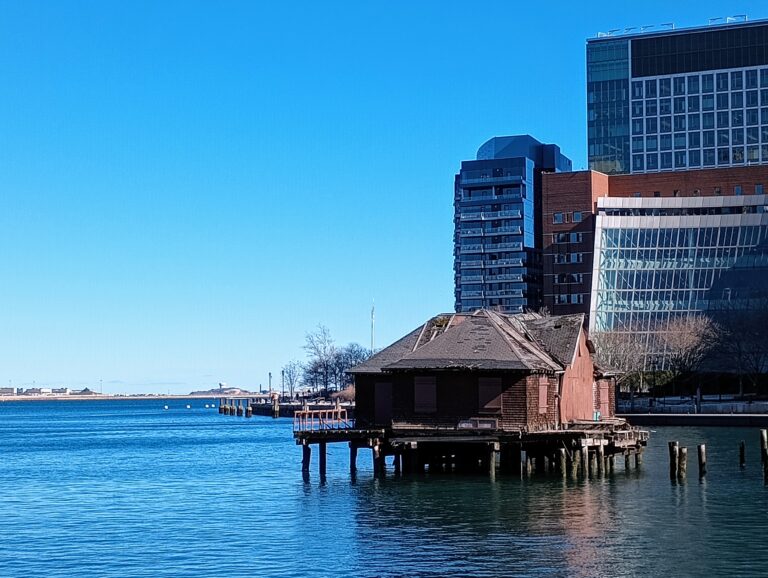Physical Address
304 North Cardinal St.
Dorchester Center, MA 02124
Physical Address
304 North Cardinal St.
Dorchester Center, MA 02124

Are rising prices in Kalamazoo a symptom of “climate refugees” moving to the cool, Rust Belt uplands? That’s a hypothesis put forward by a friend who works in the climate-insurance-housing cost nexus. It’s a provocative hypothesis. How else can one…

Urbanists and zoning reformers would really like estimates that tell us how changing the built environment will change our own habits. But many of the variables that inform Jones' estimates won't change with environment: age, race, income, education. The fault is not in our stars, but in ourselves.

Many readers of this blog know that government subsidizes driving- not just through road spending, but also through land use regulations that make walking and transit use inconvenient and dangerous. Gregory Shill, a professor at the University of Iowa College of Law, has written an excellent new paper that goes even further. Of course, Shill discusses anti-pedestrian regulations such as density limits and minimum parking requirements. But he also discusses government practices that make automobile use far more dangerous and polluting than it has to be. For example, environmental regulations focus on tailpipe emissions, but ignore environmental harm caused by roadbuilding and the automobile manufacturing process. Vehicle safety regulations make cars safer, but American crashworthiness regulations do not consider the safety of pedestrians in automobile/pedestrian crashes. Speeding laws allow very high speeds and are rarely enforced. If you don’t want to read the 100-page article, a more detailed discussion is at Streetsblog.
By Christopher Koopman and Josh T. Smith Facing a current housing crisis that is putting working families on the brink of homelessness, it would seem like California would have one of two options. The state could take steps to alleviate the growing problem. Alternatively, it could sit on its hands and do nothing at all. It seems, however, the state has found a third option: make matters worse. After it’s vote last week, the California Energy Commission took another step toward requiring all new homes under three stories to have solar panels installed beginning in 2020. Right now only between 15 and 20 percent of new single-family homes in California install rooftop solar. While solar may make economic and environmental sense for some, mandating it for all Californians will backfire by worsening the state’s housing affordability crisis, disincentivizing the building of newer, more energy efficient houses, and continuing to hurt the poor in a state that is already home to the highest rate of unsheltered homeless in the nation. The housing crisis in California is largely driven by a simple economic problem: housing supply has failed to keep up with demand. As the demand for homes in the Golden State has increased, the housing supply has failed to respond. Why? In particular, restrictive zoning policies continue to slow development and force prices up. Now people making $80,000 a year are having a hard time finding affordable housing. Make no mistake, skyrocketing housing prices are a growing problem in large cities across the country, but especially so in California. The 2017 Los Angeles Homeless Services Authority report estimated there was a 23 percent increase in homelessness from 2016 to 2017. That’s almost 11,000 additional people without homes. By mandating solar panels on all new houses, California’s regulators are essentially adding $9,500 to […]
Davis, CA, is a small college town a twenty minutes’ drive outside of Sacramento (on a good day). It has a vacancy rate on par with Manhattan despite being surrounded by flat, developable farmland. Some critics attribute this absurd vacancy rate to Measure R, a ballot initiative approved by Davis residents in 2000 that requires a public vote on any peripheral development. Since it’s passage, three developments went up for a vote, and all of them failed. The group that defends Measure R is known as the “Citizens for Responsible Planning” or CRP. Throughout various development battles, CRP has strategically utilized air quality concerns to push new development further away from existing neighborhoods. They opposed the most recent Measure R development, Nishi Gateway, because toxic air quality made the site virtually uninhabitable, at least in their minds! In fairness: the site is sandwiched between railroad tracks and a major highway, Interstate 80. So it’s a real concern. But fast-forward just six months later, and CRP is demanding the University of California, Davis, the area’s largest employer, dramatically expand its on-campus housing options for students, staff, and faculty. In an effort to appear proactive, they produce a map of optimal sites to locate student housing on the UC Davis Campus. One of the sites they select is adjacent to the Nishi parcel they so aggressively opposed development on just six months earlier. Another parcel they suggest building housing on is also sandwiched between the same railroad tracks and highway that Nishi sat between, but just a couple miles further south (and further from existing neighborhoods). You can see all of this in a map provided below, where the Nishi site they killed at the ballot is marked in red and the sites they claim to support student housing on are colored in blue: […]

I filmed this video about Whisper Farms in suburban Pasadena, California. It’s an ordinary home that’s been pressed in to service as a for-profit market garden. My friend Kirsten Dirksen was kind enough to edit it in conjunction with her website www.faircompanies.com This sort of small scale local food production is generally ignored or labelled as irrelevant. It isn’t “agriculture.” It isn’t…. anything. It’s just eccentric hobbyists who like to play farmer. But I disagree. When we look at the challenges of feeding more people with fewer resources, this kind of distributed hyper-local production makes tremendous sense. Most North Americans live in suburbs. Most suburbs have substantial amounts of sunny land right next to where people live. There’s already water being used to grow ornamental landscapes. Lawns are the largest single crop in the country. Growing food instead makes sense, particularly if different people specialize in different crops. Producing food in this manner eliminates the costs associated with transporting food from remote farms to population centers. Cities themselves are a rich source of waste materials that can be turned to organic feedstocks for agricultural production and soil amendments. Provisional labor is abundant. So are local paying customers. No one is suggesting that a California mortgage can be paid by selling lettuce at the farmers market. But most “real” farms are dependent on non-farm income from a family member who works in town as well. Suburban market gardens aren’t much different. This is one piece of a larger set of responses to how to work around concentrated industrial agribusiness. [Originally published on the blog Granola Shotgun]
The Austin area has, for the 5th year running, been among America’s two fastest-growing major metro areas by population. Although everybody knows about the new apartments sprouting along transportation corridors like South Lamar and Burnet, much of the growth has been in our suburbs, and in suburban-style areas of the city. Our city is growing out more than up. How come? The desire for living in central Austin has never been higher. But Austin, like most cities, has rules that prevent new housing from getting centrally built. That makes it easier to buy and build on virgin land in the suburbs. Here are some of those rules. 1 MINIMUM LOT SIZE Historically, expensive houses were built on expensive, large lots; cheaper homes were built on smaller, cheaper lots. Austin decided that new houses can’t be built on small lots. Even if you want to build a small, cheap house, you still need a lot with at least 5,750 square feet. In central Austin, that costs a lot of money, even without the house! If somebody owns a 10,000 square foot lot, they aren’t allowed to split it into two 5,000 square foot lots and build two medium-sized houses, let alone three 3,333 square foot lots with three small houses, let alone three 3,333 square foot lots with triplexes! In 1999, Houston reformed its minimum lot size laws. Since then, environmentally-friendly central-city urban townhomes have flourished. 2 MINIMUM SITE AREA For areas that are zoned for apartments and condos, there is a cap on the ratio of number of apartments to lot size known as “minimum site area.” 3 IMPERVIOUS COVER MAXIMUMS Impervious cover is any surface that prevents water from seeping into the ground, including buildings, driveways, and garages. There is a cap on the ratio of impervious cover to lot size. 4 FLOOR-TO-AREA RATIO MAXIMUMS Floor-to-area ratios (aka FAR) maximums are a cap on […]
This post originally appeared at Neighborhood Effects, a Mercatus Center blog about state and local policy and economic freedom. At The Atlantic Cities, Emily Badger writes about a new program from the Rockefeller Foundation called 100 Resilient Cities, focused on equipping cities with a new employee called a Chief Resiliency Officer. The program states its goals as follows: Building resilience is about making people, communities and systems better prepared to withstand catastrophic events – both natural and manmade – and able to bounce back more quickly and emerge stronger from these shocks and stresses. [. . .] There are some core characteristics that all resilient systems share and demonstrate, both in good times and in times of stress: Spare capacity, which ensures that there is a back-up or alternative available when a vital component of a system fails. Flexibility, the ability to change, evolve, and adapt in the face of disaster. Limited or “safe” failure, which prevents failures from rippling across systems. Rapid rebound, the capacity to re-establish function and avoid long-term disruptions. Constant learning, with robust feedback loops that sense and allow new solutions as conditions change. In his book Antifragile: Things that Gain from Disorder, Nassim Taleb defines antifragile as something that not only recovers from shocks, but becomes stronger after recovery, in line with the stated objectives of 100 Resilient Cities. Following its Great Fire of 1871, Chicago demonstrated antifragility. It rebounded rapidly from a disaster that killed 300 people and left one-third of city residents homeless, many without insurance after the fire bankrupted local insurers or the blaze destroyed their paperwork. Despite this great loss, residents of Chicago quickly rebuilt their city using private funding and private charity that was small relative to the amount of damage, but without any government funding. In rebuilding, Chicago developed safer building techniques both through entrepreneurship and with new insurance requirements and new municipal […]
California has, since the ’70s, had some of the strictest environmental laws in the country, but urbanists have recently been frustrated by what are known as CEQA lawsuits, named after the 1970 California Environmental Quality Act that serves as the basis of the challenges. CEQA battles have certainly hindered their fair share of highway and road projects, but they also affect transit and urban infill development, perhaps a perversion of the law’s pro-environmental intent. Skirmishes over the law have yielded mixed results – transit projects were made more vulnerable by a recent ruling, while affordable housing projects are now less prone to CEQA challenges – but there has recently been talk of more major CEQA reform.
Andrés Duany, leader of the New Urbanism movement, comes out against LEED standards: He said that high-density development in urban locations which entail less reliance on private cars should get a free pass on energy efficiency or energy generation standards. “Don’t make apartment dwellers install solar power,” he said. “They are doing their part just by living densely and driving less.” […] Duany also had choice words for government land use and building officials. In New Orleans, he said that government standards for rebuilding added costs that just about exactly offset the amount of assistance the government was going to provide, so “no one can rebuild.”